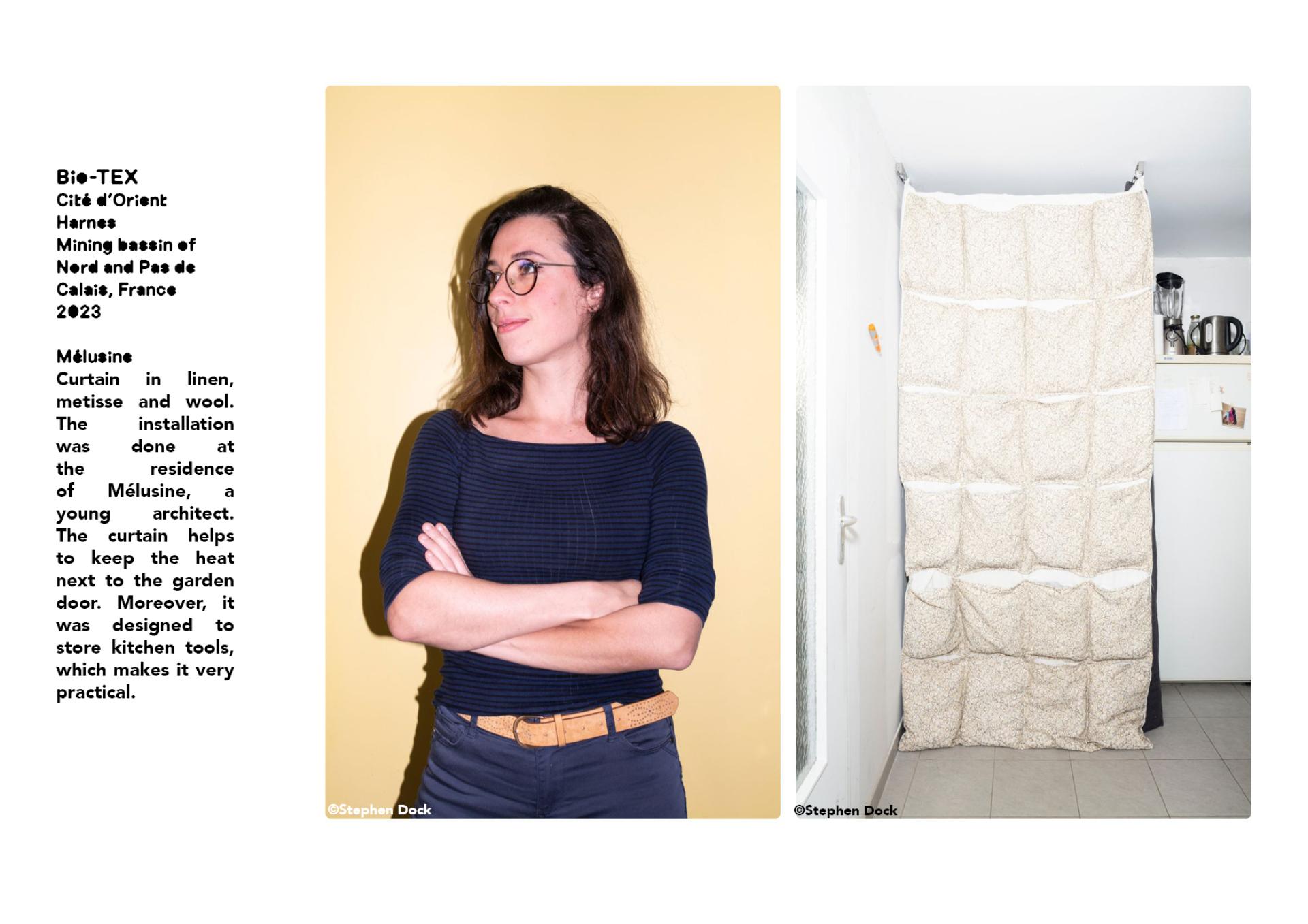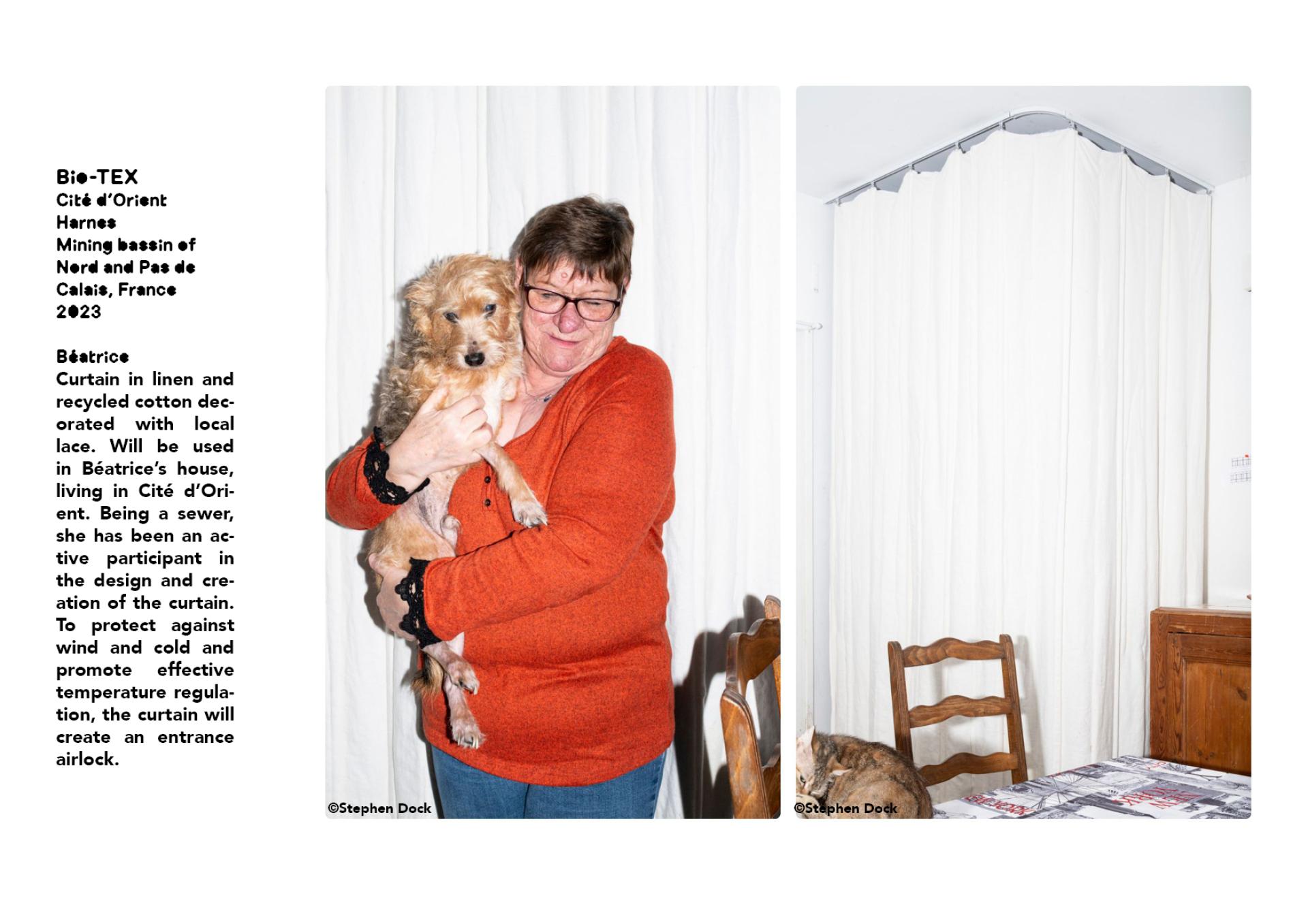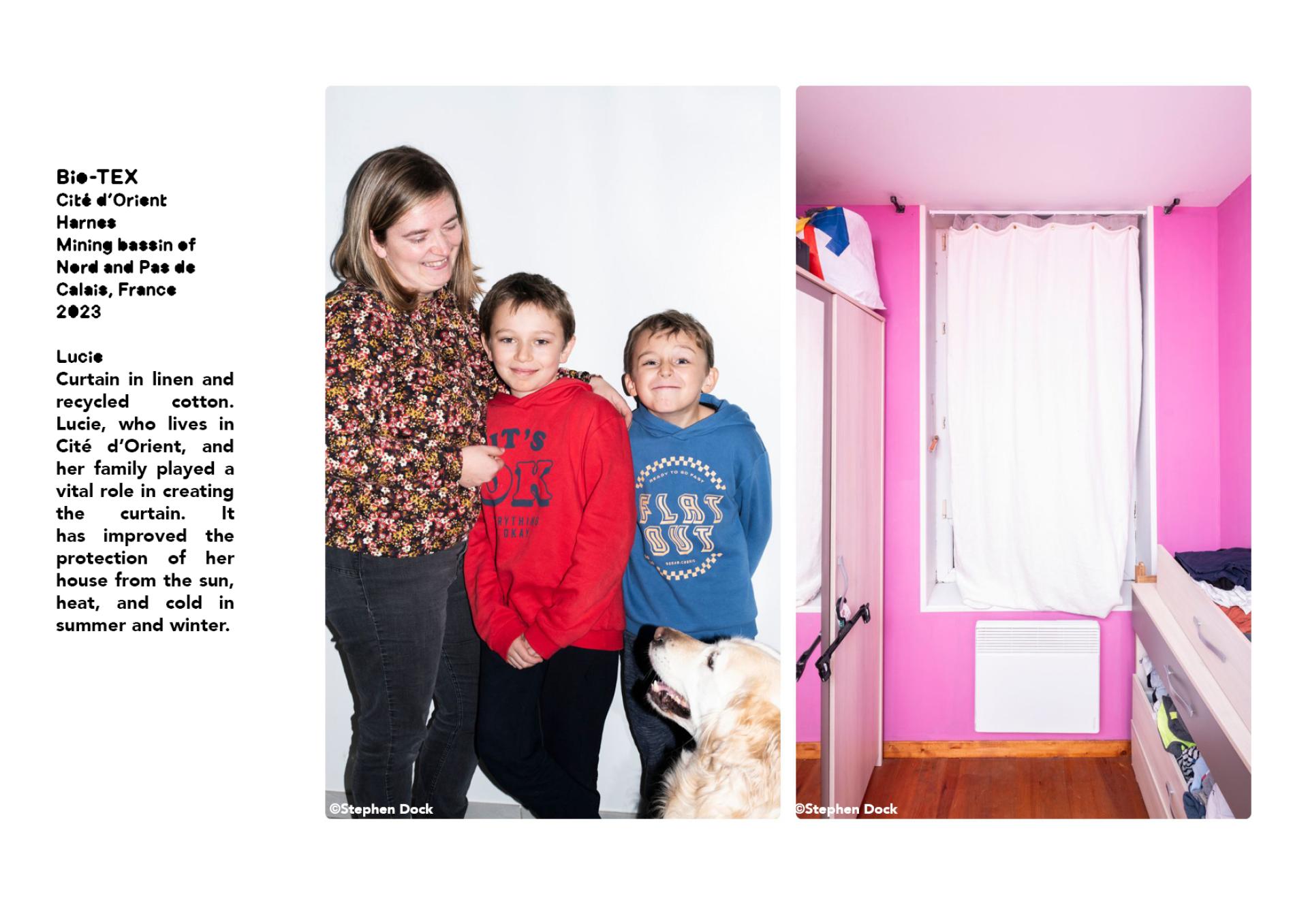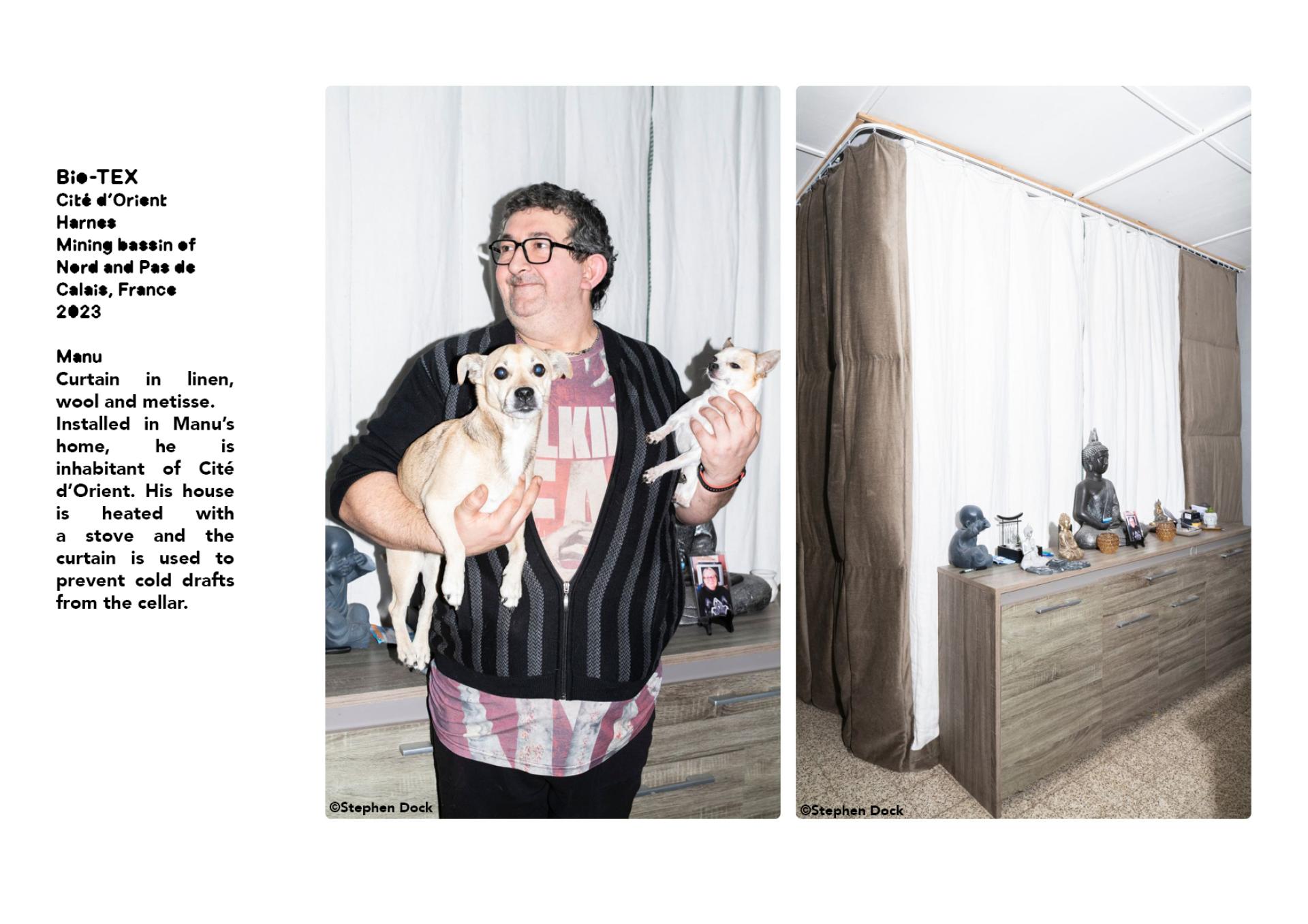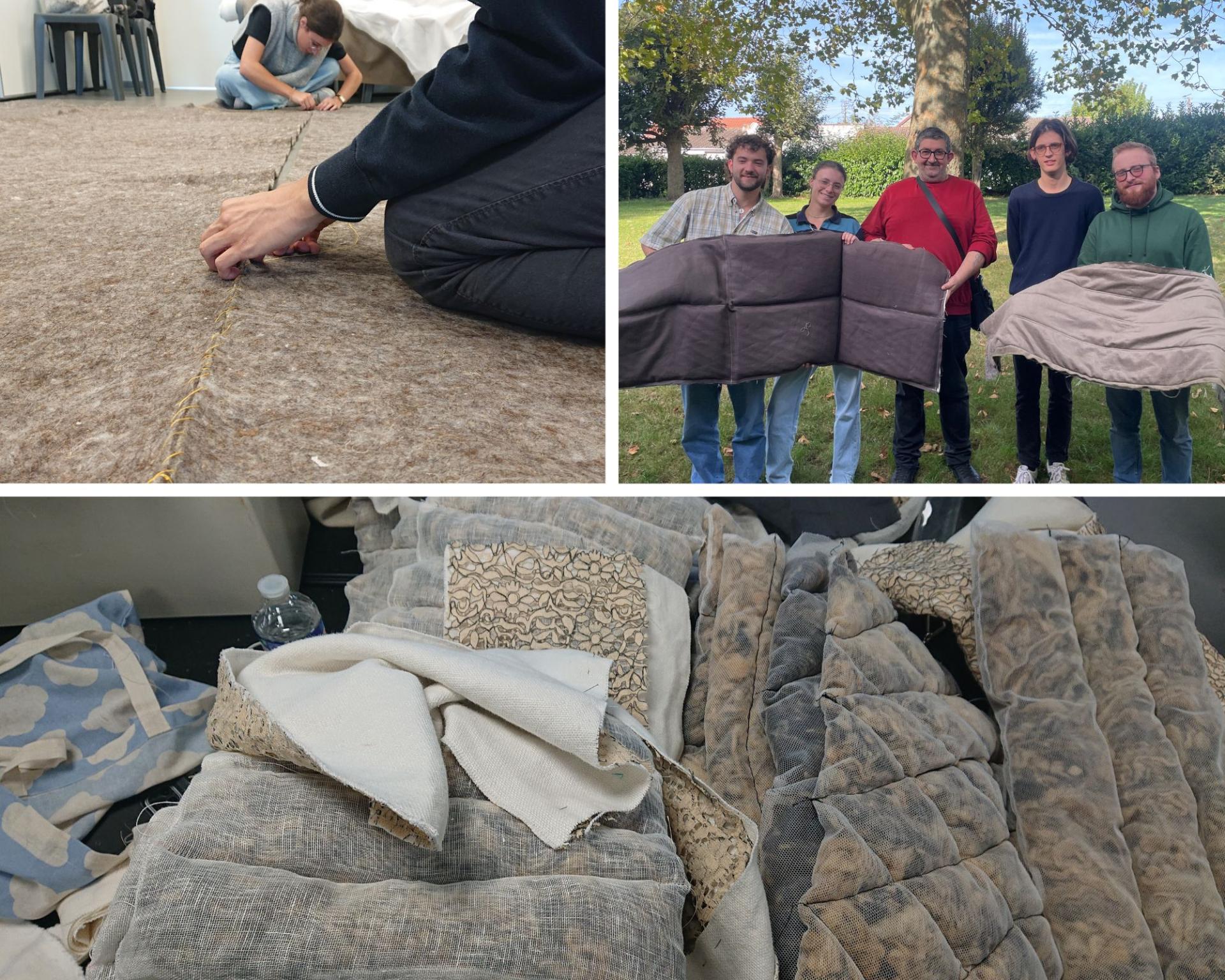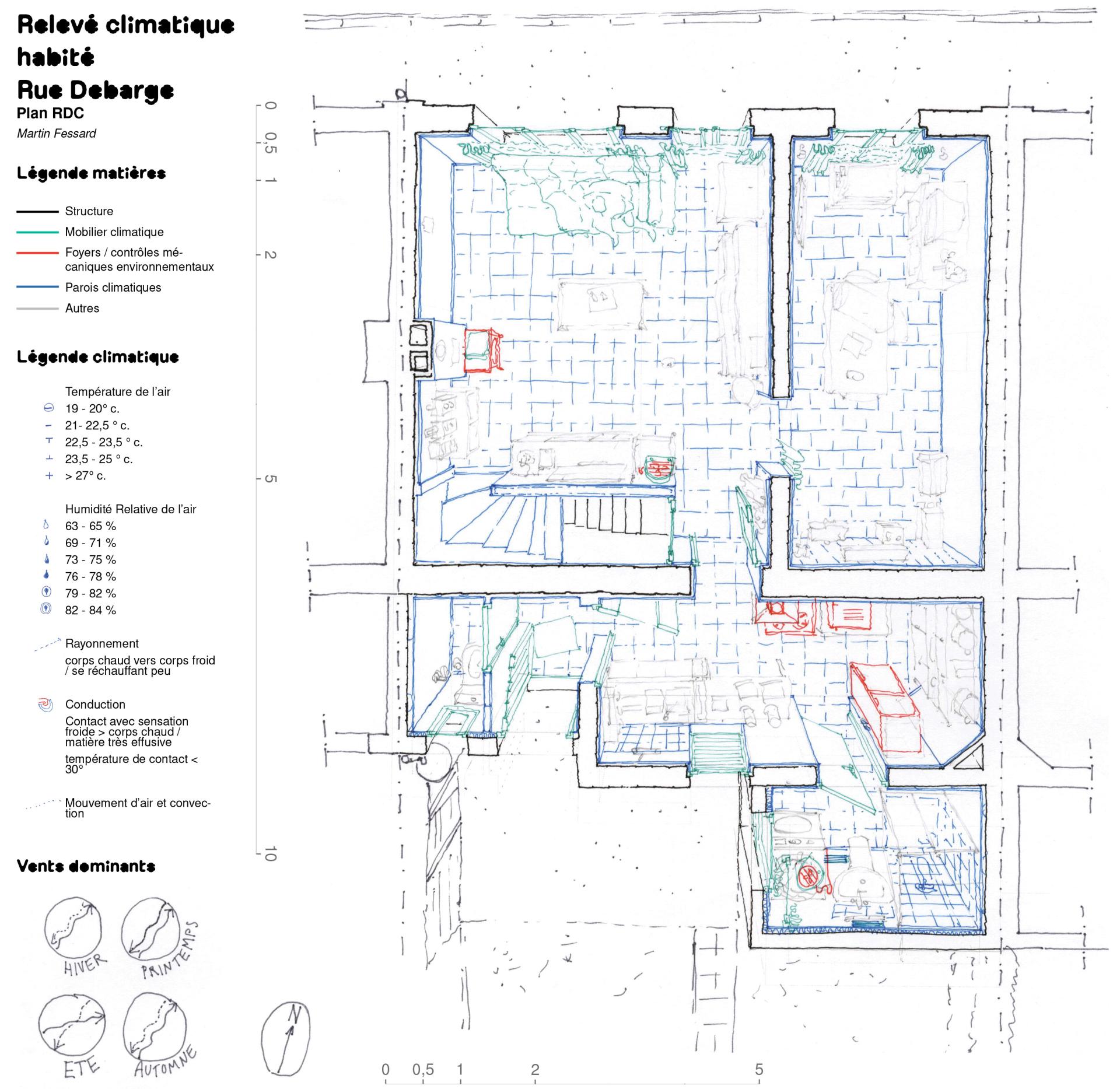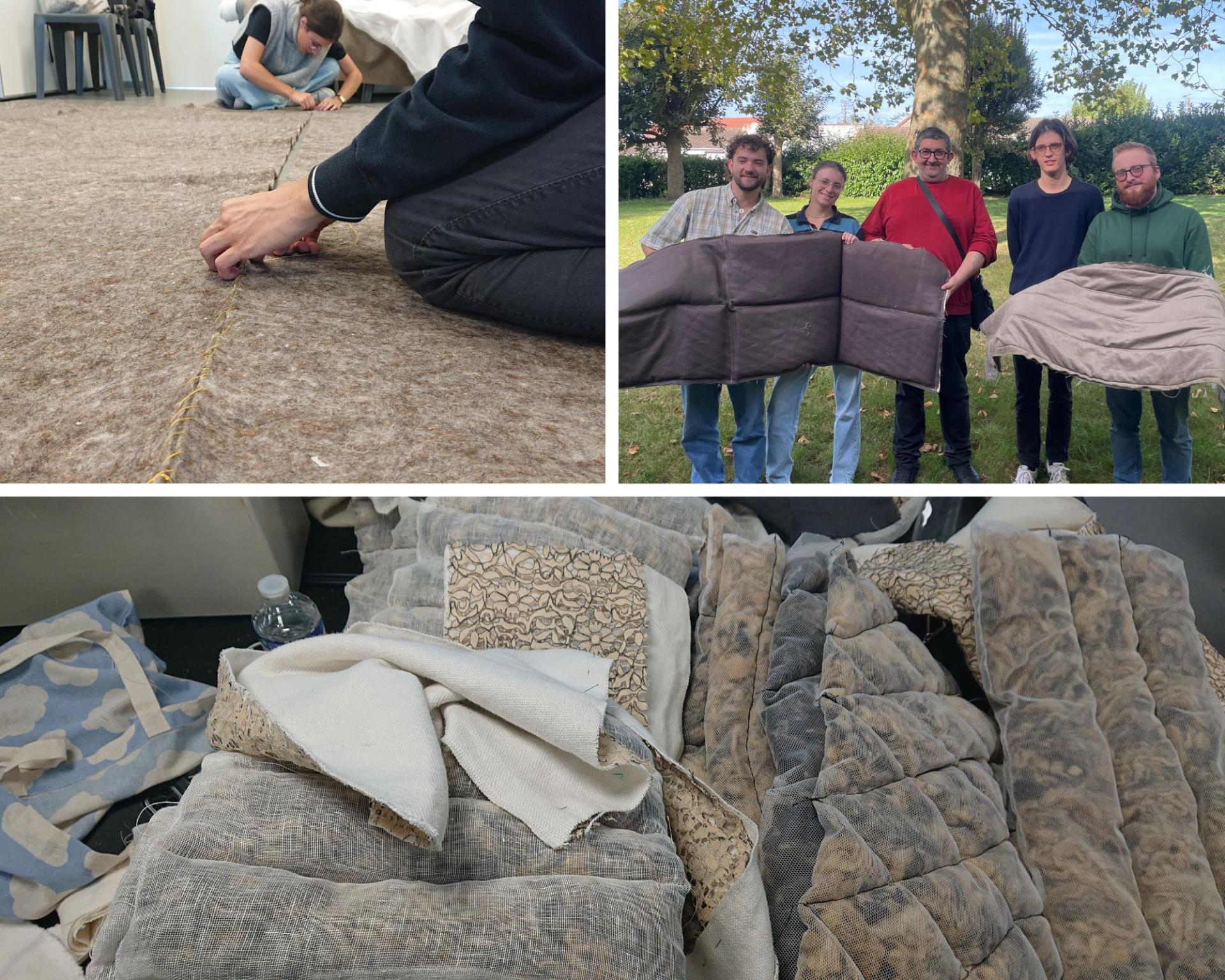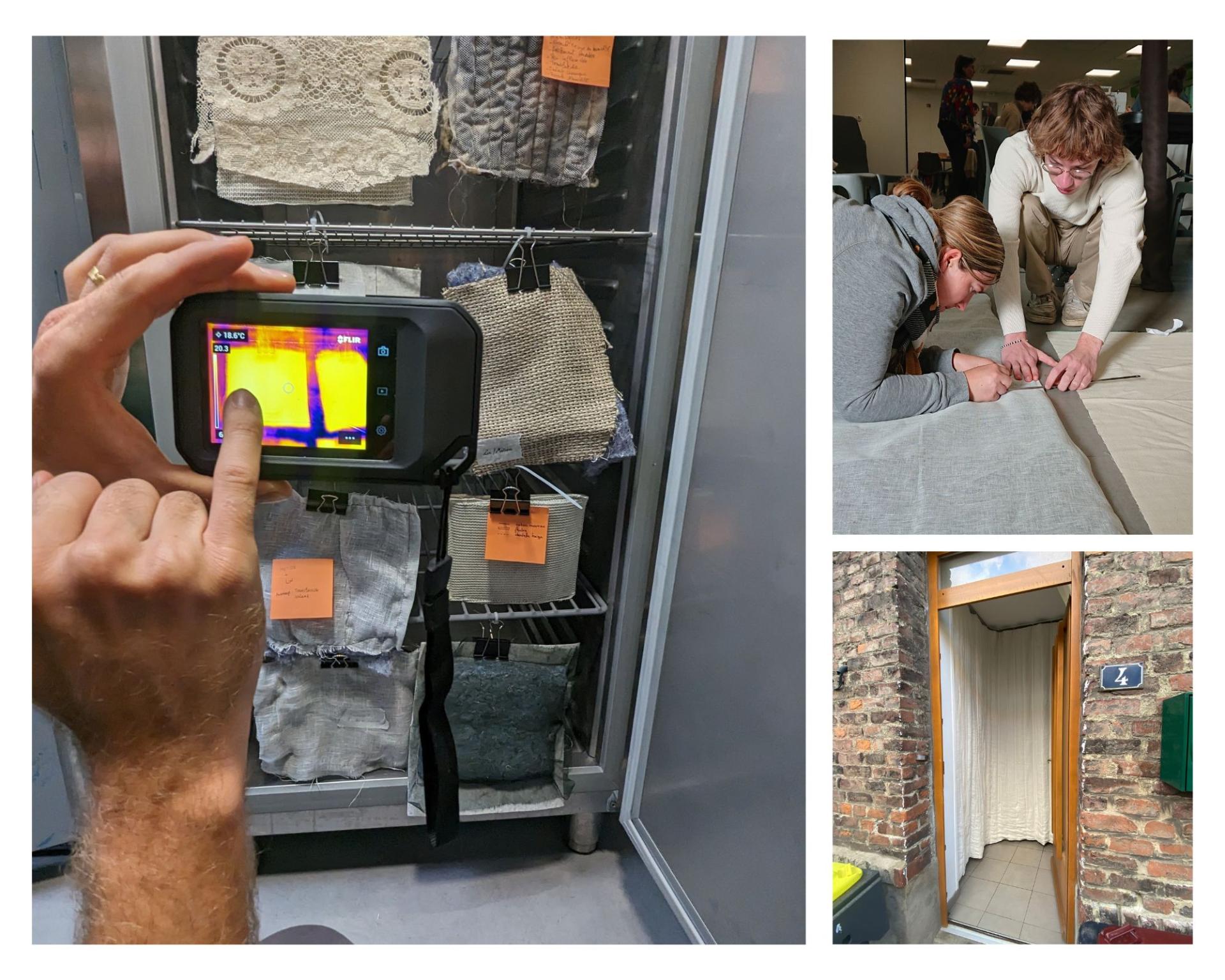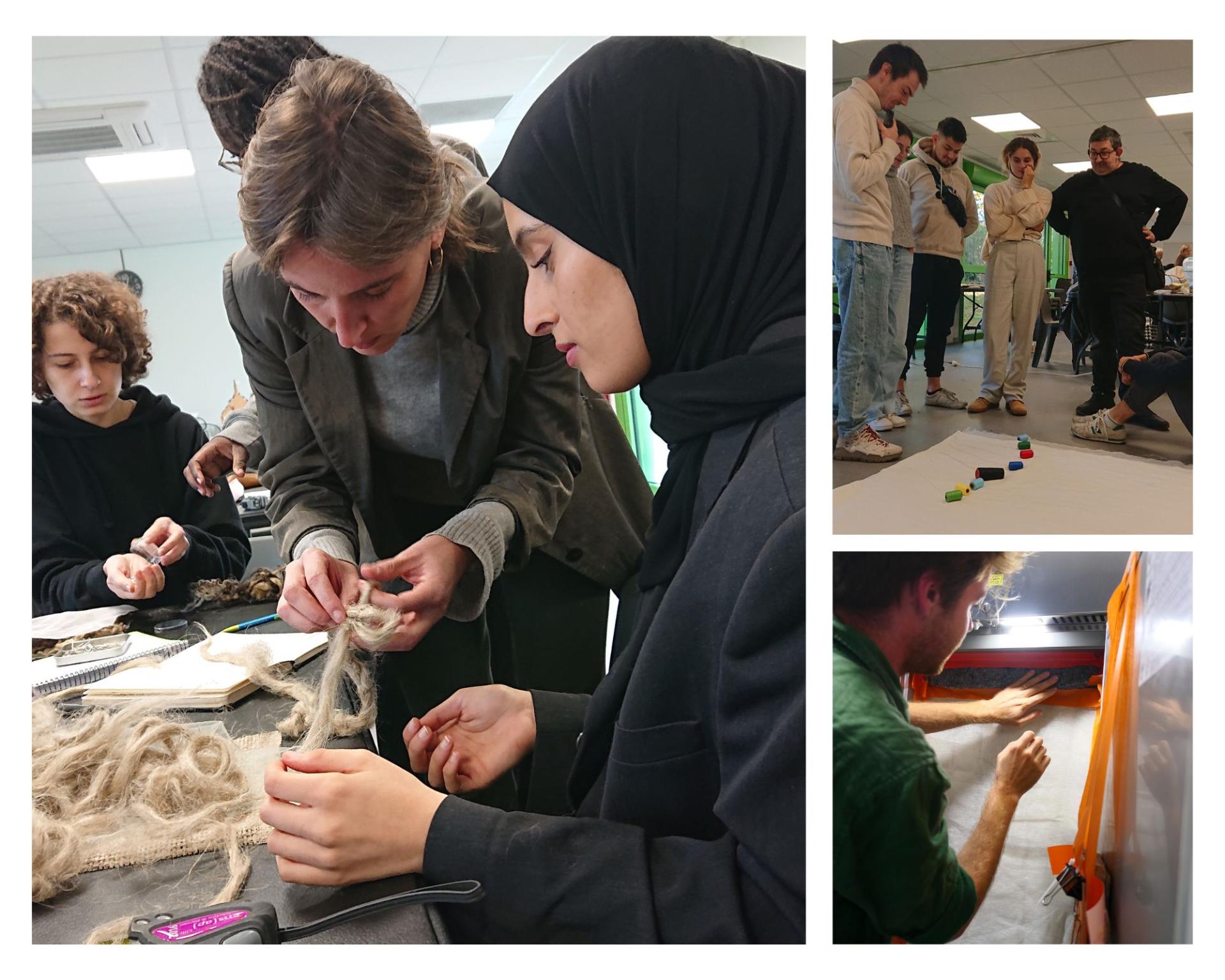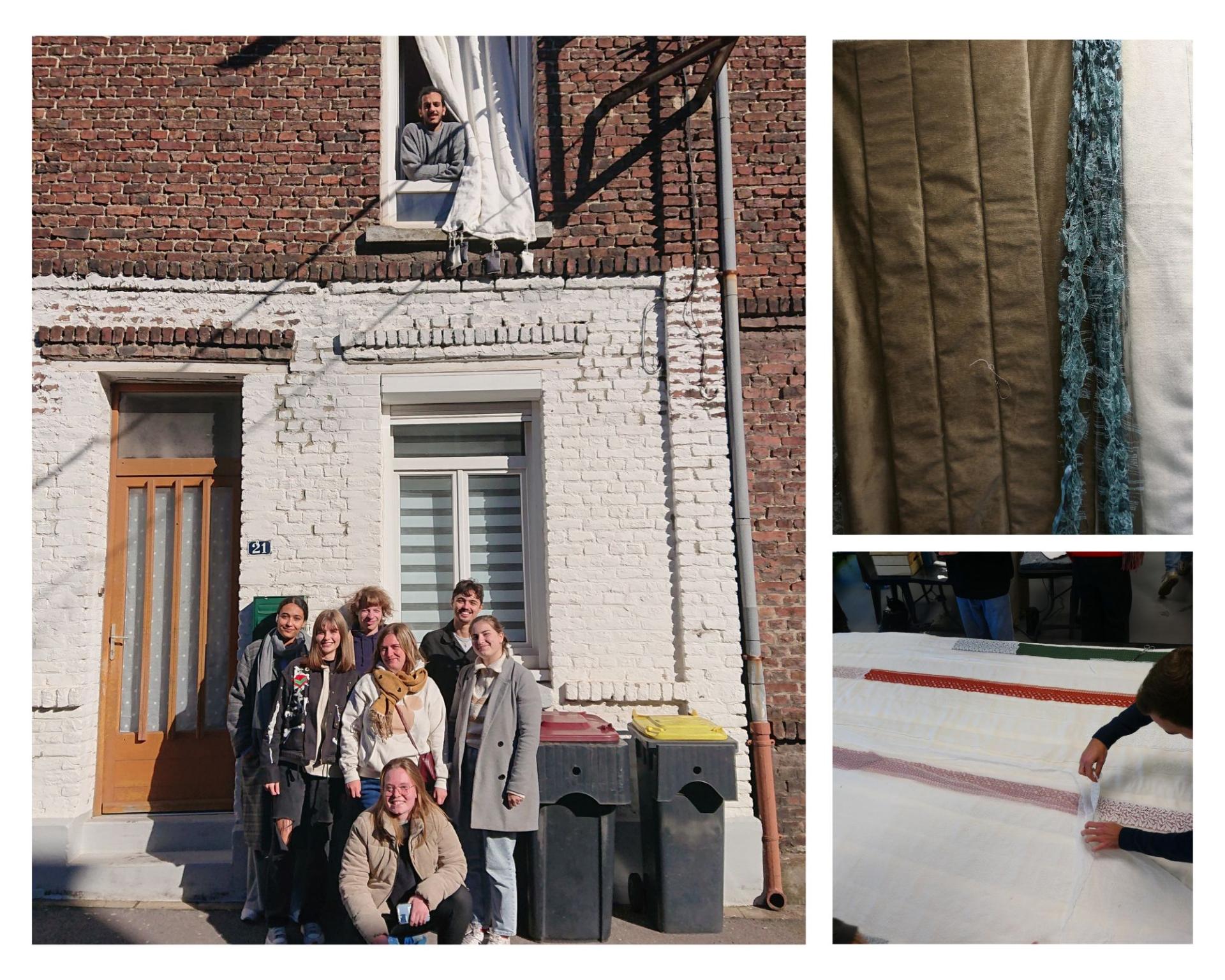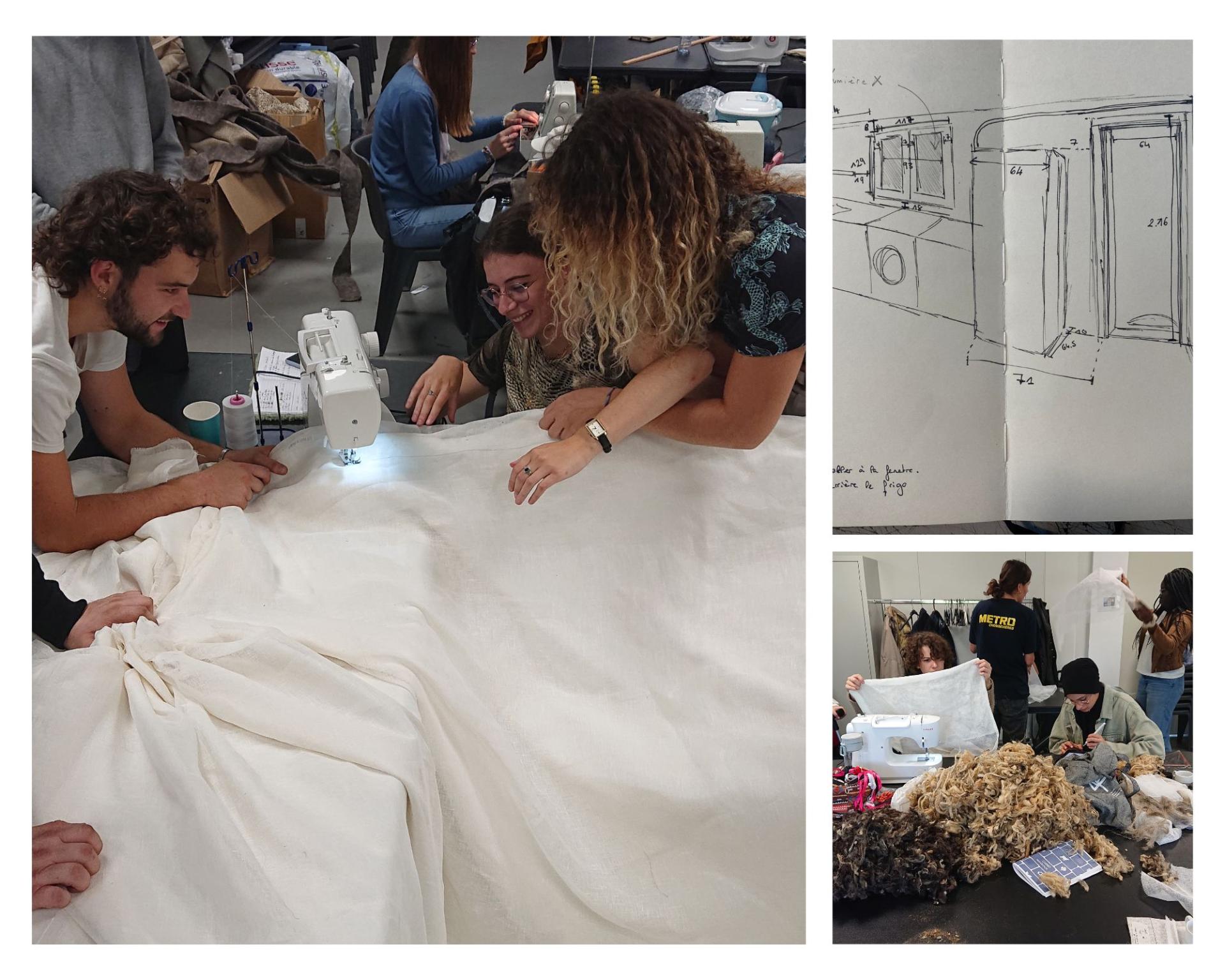Bio-TEX
Basic information
Project Title
Bio-TEX
Category
Shaping a circular industrial ecosystem and supporting life-cycle thinking
Project Description
ddddda
Geographical Scope
Regional
Project Region
H, France
Urban or rural issues
It addresses urban-rural linkages
Physical or other transformations
It refers to a physical transformation of the built environment (hard investment)
EU Programme or fund
No
Description of the project
Summary
To renovate mining houses, the Bio-TEX project involves making hygrothermal curtains. 4 large curtains, combining thermal function (cutting off cold radiation, stopping cold air current, sun/heat protection), hygroscopic (storing water vapor, CO2 and Volatile Organic Compounds (VOCs)), and aesthetics (fluid and warm to the touch) to improve Harne's inhabitant's comfort and air quality have been created.
We re-invent the mining town's renovation through a technical, artistic, and collaborative research-action project, based on a close relationship between lifestyles, interior environments, techniques, and the housing context. The objective is to shape a circular industrial textile ecosystem and impact the energy renovation sector in the mining basin of Nord and Pas-de-Calais which, has suffered from mining and now is part of Just Transition.
We link body's well-being to the living modes by combining bioclimatic architecture and mastery of one's self-comfort. The place of textiles in the house is a unique approach proposed to give an affordable opportunity to modulate space according to needs with evolving microclimates tied to use and lifestyle allowing reduce energy consumtion. Local natural textile ensures lifecycle thinking. We thus reconnect with traditional interiors that valued fabrics, carpets and four-poster beds. The curtains are known as both thermal and decorative, are easily able to solve architectural elements like the entrance airlock and creation of interior sub-spaces due to their temporary nature. These ideas are radical and involve significant upheavals on a regional level in terms of demands and expectations of inhabitants, local suppliers, national policy, and regulations.
We brought together designers, textile engineers, researchers, students, local suppliers and NGOs, authorities as well as the residents.
The project embraces sustainability, participation, inclusion, and aesthetics by improving the daily life of locals.
We re-invent the mining town's renovation through a technical, artistic, and collaborative research-action project, based on a close relationship between lifestyles, interior environments, techniques, and the housing context. The objective is to shape a circular industrial textile ecosystem and impact the energy renovation sector in the mining basin of Nord and Pas-de-Calais which, has suffered from mining and now is part of Just Transition.
We link body's well-being to the living modes by combining bioclimatic architecture and mastery of one's self-comfort. The place of textiles in the house is a unique approach proposed to give an affordable opportunity to modulate space according to needs with evolving microclimates tied to use and lifestyle allowing reduce energy consumtion. Local natural textile ensures lifecycle thinking. We thus reconnect with traditional interiors that valued fabrics, carpets and four-poster beds. The curtains are known as both thermal and decorative, are easily able to solve architectural elements like the entrance airlock and creation of interior sub-spaces due to their temporary nature. These ideas are radical and involve significant upheavals on a regional level in terms of demands and expectations of inhabitants, local suppliers, national policy, and regulations.
We brought together designers, textile engineers, researchers, students, local suppliers and NGOs, authorities as well as the residents.
The project embraces sustainability, participation, inclusion, and aesthetics by improving the daily life of locals.
Key objectives for sustainability
Our responsibility is to take care of the territory we live and work in. The Cité d'Orient is a declining community, with vernacular architectural ensembles dating from the beginning of the 20th century, totally unprepared for climate change, needing energy and social regeneration. Our 3 key sustainability objectives:
1. Climate change adaptation
The curtain is an affordable, ecological, resource-efficient, and beautiful tool to address climate change among inhabitants. It combines thermal function (cutting off cold radiation from the wall, stopping a current of cold/hot air coming from a window, etc.), hygroscopic (capacity to store water vapor, even CO2 and VOCs) and aesthetics (visually comfortable, softness of touch). It improves the daily comfort and air quality inside the house. The curtains production requires small CO2 emissions since local materials (linen, wool, re-used textile) are used and provided by small-scale local textile industries (Northern France in our case, but each territory in Europe can find its own local materials). It is also a high-quality eco-responsible product lasting for decades going from one generation to the next.
2. Environmental and social benefits
Helping the inhabitants to reappropriate the resources (materials, know-how) of their own territory by co-design and self-making
Curtains are inspired by ancient know-how: cost-effective, providing environmental, social and economic benefits.
3. Climatic art and handicraft
The renovation is a chance to question the beauty of the house interiors and the inhabitant's capacity to control felt and sensual comfort, involving the soft touch, warm vision, and the comforting feel of the curtains in the house. The curtains' ornamentation brings joy to caring for and decorating its interior. The curtains are a tool of a climate lifestyle, where inhabitant adapt its habits and spaces to the changing seasons and day, forming new connections between the interior and the surroundings.
1. Climate change adaptation
The curtain is an affordable, ecological, resource-efficient, and beautiful tool to address climate change among inhabitants. It combines thermal function (cutting off cold radiation from the wall, stopping a current of cold/hot air coming from a window, etc.), hygroscopic (capacity to store water vapor, even CO2 and VOCs) and aesthetics (visually comfortable, softness of touch). It improves the daily comfort and air quality inside the house. The curtains production requires small CO2 emissions since local materials (linen, wool, re-used textile) are used and provided by small-scale local textile industries (Northern France in our case, but each territory in Europe can find its own local materials). It is also a high-quality eco-responsible product lasting for decades going from one generation to the next.
2. Environmental and social benefits
Helping the inhabitants to reappropriate the resources (materials, know-how) of their own territory by co-design and self-making
Curtains are inspired by ancient know-how: cost-effective, providing environmental, social and economic benefits.
3. Climatic art and handicraft
The renovation is a chance to question the beauty of the house interiors and the inhabitant's capacity to control felt and sensual comfort, involving the soft touch, warm vision, and the comforting feel of the curtains in the house. The curtains' ornamentation brings joy to caring for and decorating its interior. The curtains are a tool of a climate lifestyle, where inhabitant adapt its habits and spaces to the changing seasons and day, forming new connections between the interior and the surroundings.
Key objectives for aesthetics and quality
The mining basin is noteworthy for its aesthetics, owing to its landscapes and vernacular architecture. The interior design of housing has always been very important for miners and their families, as they tried to add more sunshine and color in order to create the contrast to the dark mines shafts. Colored wallpaper and curtains were commonly employed to accomplish this task. We aimed to keep this tradition alive and upgrade the curtain, enhancing its aesthetic and hygrothermal qualities.
The entire architectural language is involved as long as the curtain is created using natural and living local materials (linen, wool, plants) and self-making is encouraged. We not only value the culture and memory that is already there, but we also work to create new ones keeping each house beautiful and unique while respecting the environment and adapting to climate change.
Bio-TEX meet the value of aesthetics and quality of experience in the following way: take inspiration from the existing local context and create a distinctive identity for every house at the same time; Engage in visual storytelling that captures the essence of each house, family, habit, and culture; The curtain concept can be replicated in any other house, making it a universal design.
The entire architectural language is involved as long as the curtain is created using natural and living local materials (linen, wool, plants) and self-making is encouraged. We not only value the culture and memory that is already there, but we also work to create new ones keeping each house beautiful and unique while respecting the environment and adapting to climate change.
Bio-TEX meet the value of aesthetics and quality of experience in the following way: take inspiration from the existing local context and create a distinctive identity for every house at the same time; Engage in visual storytelling that captures the essence of each house, family, habit, and culture; The curtain concept can be replicated in any other house, making it a universal design.
Key objectives for inclusion
The Bio-TEX project is committed to meeting the unique demands and requirements of every inhabitant, preventing exclusion, and creating a welcoming atmosphere that encompasses all members of the community.
The conception and fabrication of the curtains during the series of creative workshops involved a different range of interested individuals, among them there are: youth (students from Lille's School of Architecture and young people supported by the Municipal Social Action Center), families (inhabitants of the Cité d'Orient - men and women, children, teenagers, seniors), designers (About a Worker and Emma Cogné). Also, various organizations and communities are involved, such as local NGO Corons d'Orient, Mission Bassin Minier, and local authorities such as City of Harnes and Comunauté d'Agglomération de Lens-Lièvin. Each workshop and event was facilitated by designers, researchers from Lille School of Architecture and PhD students helping in the adaptation of curtain creation for different participants (children can complete simple tasks while adults can complete more challenging tasks), the friendly ambiance encouraged a dialogue across cultures, disciplines, genders and ages.
The hygrothermal curtain that was created is already in use in the homes of the residents. This is an exemplary design in terms of inclusion because it prioritizes designing for all, respecting diversity, and ensuring accessibility and affordability.
Our aim was to create a living space that is accessible, inclusive, and beautiful for all, regardless of age or abilities.
The conception and fabrication of the curtains during the series of creative workshops involved a different range of interested individuals, among them there are: youth (students from Lille's School of Architecture and young people supported by the Municipal Social Action Center), families (inhabitants of the Cité d'Orient - men and women, children, teenagers, seniors), designers (About a Worker and Emma Cogné). Also, various organizations and communities are involved, such as local NGO Corons d'Orient, Mission Bassin Minier, and local authorities such as City of Harnes and Comunauté d'Agglomération de Lens-Lièvin. Each workshop and event was facilitated by designers, researchers from Lille School of Architecture and PhD students helping in the adaptation of curtain creation for different participants (children can complete simple tasks while adults can complete more challenging tasks), the friendly ambiance encouraged a dialogue across cultures, disciplines, genders and ages.
The hygrothermal curtain that was created is already in use in the homes of the residents. This is an exemplary design in terms of inclusion because it prioritizes designing for all, respecting diversity, and ensuring accessibility and affordability.
Our aim was to create a living space that is accessible, inclusive, and beautiful for all, regardless of age or abilities.
Results in relation to category
The first step in describing the outcomes and impacts is to share a testimonial from an inhabitant: “The curtain allows me to keep the heat next to the garden door. In addition, it was designed to allow me to keep the kitchen tools, so it is very practical.”
The project has directly benefited four families, who have installed the hygrothermal curtain in their homes, which has led to a decrease in energy consumption and improved the well-being and aesthetics of their homes. The curtain has been designed to serve as a tool in the renovation of 40.000 houses in the upcoming years.
The project outcome is about changing patterns in the textile and renovation ecosystem of Nord and Pas-de-Calais, as well as the entirety of the Hauts-de-France region.
The benefits are available to both direct and indirect beneficiaries:
- The use of hygrothermal curtains has resulted in an increase in energy efficiency for mining houses in Cité d’Orient, Nord and Pas-de-Calais.
- Enable residents to gain a better understanding of climate change and use affordable tools to adapt their homes
- Local stakeholders are now better equipped to participate in policymaking and renovation processes
- A new circular textile ecosystem is being created, with civil society, local and regional policy-makers, economic stakeholders, and academic institutions involved
- The energy renovation sector is being reimagined to provide tools that are economical, ecological, and affordable for all.
- Making the New European Bauhaus principles more accessible to the local territories
The project has directly benefited four families, who have installed the hygrothermal curtain in their homes, which has led to a decrease in energy consumption and improved the well-being and aesthetics of their homes. The curtain has been designed to serve as a tool in the renovation of 40.000 houses in the upcoming years.
The project outcome is about changing patterns in the textile and renovation ecosystem of Nord and Pas-de-Calais, as well as the entirety of the Hauts-de-France region.
The benefits are available to both direct and indirect beneficiaries:
- The use of hygrothermal curtains has resulted in an increase in energy efficiency for mining houses in Cité d’Orient, Nord and Pas-de-Calais.
- Enable residents to gain a better understanding of climate change and use affordable tools to adapt their homes
- Local stakeholders are now better equipped to participate in policymaking and renovation processes
- A new circular textile ecosystem is being created, with civil society, local and regional policy-makers, economic stakeholders, and academic institutions involved
- The energy renovation sector is being reimagined to provide tools that are economical, ecological, and affordable for all.
- Making the New European Bauhaus principles more accessible to the local territories
How Citizens benefit
Civil society and individuals of all ages and diversity, including men, women, children, youth, disabled people, and minorities, are all involved in the Bio-TEX project, which is completely participatory.
The citizens benefiting and affected by the project have been involved in the project by means of in-situ experimentation: creation and discovery of new ways of learning and making, making their voice heard, regaining the sense of belonging and re-appropriating the resources of their own territory.
Although designers, professors, and PhD students from Lille's School of Architecture provided facilitation for the in-situ workshops, the citizens, both residents and students, were the ones who conducted them. The impact of this involvement on the project is:
- commitment and acceptance: citizens who participated in the process showed significant commitment to help make the project happen. For instance, one of the participants was a former seamstress. This commitment allows the wide solution acceptance among other community members and inhabitants of the mining basin.
- effectiveness and local solution: bringing local knowledge to create a circular industrial ecosystem
- create and support local networks of community members - making the community more resilient and united.
- create a long-term ecosystem: regular, ongoing discussions and experimentation allow to improve the socio-economic development of the region, to work on guidelines and methods facilitating the creation of a circular industrial ecosystem with and for the citizens.
Currently, we aim to design a curtain system that is both industrially viable and open-source for the renovation of 25 houses, following the workshops with residents and the continued design work with designers, researchers, and social landlords. The conditions of replicability for the other mining sites to be renovated (about 40,000) will be studied after this experimental operation and its evaluation.
The citizens benefiting and affected by the project have been involved in the project by means of in-situ experimentation: creation and discovery of new ways of learning and making, making their voice heard, regaining the sense of belonging and re-appropriating the resources of their own territory.
Although designers, professors, and PhD students from Lille's School of Architecture provided facilitation for the in-situ workshops, the citizens, both residents and students, were the ones who conducted them. The impact of this involvement on the project is:
- commitment and acceptance: citizens who participated in the process showed significant commitment to help make the project happen. For instance, one of the participants was a former seamstress. This commitment allows the wide solution acceptance among other community members and inhabitants of the mining basin.
- effectiveness and local solution: bringing local knowledge to create a circular industrial ecosystem
- create and support local networks of community members - making the community more resilient and united.
- create a long-term ecosystem: regular, ongoing discussions and experimentation allow to improve the socio-economic development of the region, to work on guidelines and methods facilitating the creation of a circular industrial ecosystem with and for the citizens.
Currently, we aim to design a curtain system that is both industrially viable and open-source for the renovation of 25 houses, following the workshops with residents and the continued design work with designers, researchers, and social landlords. The conditions of replicability for the other mining sites to be renovated (about 40,000) will be studied after this experimental operation and its evaluation.
Physical or other transformations
It refers to a physical transformation of the built environment (hard investment)
Innovative character
The Bio-TEX initiative tackles complicated economic, energy, and societal challenges in post-mining territories by utilizing co-creation and climatic architecture to create hydrothermal curtains. Nowadays, the textile industry is the 2nd most polluting industry in the world behind oil. That's why we aim to transform specific elements of the textile value chain, from the sourcing of raw materials to the final distribution of finished products. We aim to add value to the local and recycled materials, propose tailored solutions for the beneficiaries, support local suppliers, and propose affordable tools for climate adaptation for the most deprived territories.
The innovative character is reflected by the following points:
I Create a new circular industrial system that can be easily replicated in any area by co-designing a hygrothermal curtain with local communities and using local traditional and innovative textile materials.
II Test the new learning methods, based on in-situ experimentation
III Consider the everyday architect and designer as a contributor to acclimatization, in close dialogue with the social, economic, and cultural context, the inhabitants, and the policy-makers, with European strategies and guidelines.
We aim to produce solutions that are both sustainable and innovative, yet affordable and life-changing for everyone, in alignment with the European Green Deal.
The initiative's innovative nature stems from its ambition to serve as an example for future climate adaptation in mining cities all across Europe.
The innovative character is reflected by the following points:
I Create a new circular industrial system that can be easily replicated in any area by co-designing a hygrothermal curtain with local communities and using local traditional and innovative textile materials.
II Test the new learning methods, based on in-situ experimentation
III Consider the everyday architect and designer as a contributor to acclimatization, in close dialogue with the social, economic, and cultural context, the inhabitants, and the policy-makers, with European strategies and guidelines.
We aim to produce solutions that are both sustainable and innovative, yet affordable and life-changing for everyone, in alignment with the European Green Deal.
The initiative's innovative nature stems from its ambition to serve as an example for future climate adaptation in mining cities all across Europe.
Disciplines/knowledge reflected
The Bio-TEX initiative shares its creative and interdisciplinary qualities with the New European Bauhaus. We create a link between diverse backgrounds, between research and action, and facilitate interactions among diverse disciplines. That's how we build participation at all levels and maximize the added value of each discipline.
Design, architecture, social sciences, heritage, ecology, circular economy, and citizen empowerment are the main disciplines reflected, and they aim to bring beauty, comfort, and high-quality experiences to people's daily lives. The life-cycle thinking is the narrative thread shaping and guiding the project through its different stages, as long as the project considers the consequences in the environmental, economic, and social fields throughout the entire life cycle of the curtain and of the concept itself.
We aim to accompany the transformational movement happening in Cité d'Orient by using interdisciplinarity as a tool.
The development of a people-centered approach involves collaboration among young architects and designers, researchers, policy-makers, social landlords, inhabitants, NGOs, and enterprises. We propose a new economic model that contributes to the transformation of the destructive industrial system towards sustainable practices. Thus, the connection between economic model, ecology, aesthetics and social challenges is made while the design is tailored to the local heritage context.
Bringing together multiple disciplines has the added value of having each partner bring their own unique and distinct set of tools and approaches to the table.
Design, architecture, social sciences, heritage, ecology, circular economy, and citizen empowerment are the main disciplines reflected, and they aim to bring beauty, comfort, and high-quality experiences to people's daily lives. The life-cycle thinking is the narrative thread shaping and guiding the project through its different stages, as long as the project considers the consequences in the environmental, economic, and social fields throughout the entire life cycle of the curtain and of the concept itself.
We aim to accompany the transformational movement happening in Cité d'Orient by using interdisciplinarity as a tool.
The development of a people-centered approach involves collaboration among young architects and designers, researchers, policy-makers, social landlords, inhabitants, NGOs, and enterprises. We propose a new economic model that contributes to the transformation of the destructive industrial system towards sustainable practices. Thus, the connection between economic model, ecology, aesthetics and social challenges is made while the design is tailored to the local heritage context.
Bringing together multiple disciplines has the added value of having each partner bring their own unique and distinct set of tools and approaches to the table.
Methodology used
Our methodology is aimed at creating a distinct connection between academic research, applied research, professional practice, and pedagogy in order to massify the initiative and create a circular industrial ecosystem.
In order to support the movement of transformation of Nord and Pas-de-Calais, we apply the holistic, participative design and experiential approach that enables a wide range of stakeholders and individuals to contribute.
We go beyond public consultation for product fabrication and enhance collaboration between citizens, designers, architects, suppliers, and social landlords by building and deepening equal collaboration. Directly implemented in the initiative is the long-term research conducted by PhD students at Lilles School of Architecture and LGCgE lab (University of Artois).
Through multi-disciplinary in-situ experimentation, we aim to connect technical, social, design, and architectural issues in our research. Our aim is to enhance energy retrofitting with aesthetic, design, heritage, and participatory approaches.
We aim to massify and develop a circular industrial ecosystem in terms of economic models. The social and proximity economies will be beneficial to Nord and Pas-de-Calais, which will contribute to overall socio-economic development.
The whole process is also about holistic approach allowing positive and collective communication, creativity, insights sharing, solidarity and test out new ideas
In order to support the movement of transformation of Nord and Pas-de-Calais, we apply the holistic, participative design and experiential approach that enables a wide range of stakeholders and individuals to contribute.
We go beyond public consultation for product fabrication and enhance collaboration between citizens, designers, architects, suppliers, and social landlords by building and deepening equal collaboration. Directly implemented in the initiative is the long-term research conducted by PhD students at Lilles School of Architecture and LGCgE lab (University of Artois).
Through multi-disciplinary in-situ experimentation, we aim to connect technical, social, design, and architectural issues in our research. Our aim is to enhance energy retrofitting with aesthetic, design, heritage, and participatory approaches.
We aim to massify and develop a circular industrial ecosystem in terms of economic models. The social and proximity economies will be beneficial to Nord and Pas-de-Calais, which will contribute to overall socio-economic development.
The whole process is also about holistic approach allowing positive and collective communication, creativity, insights sharing, solidarity and test out new ideas
How stakeholders are engaged
Energy precariousness facing global environmental problems is one of the most difficult issues facing mining basin community. The Bio-TEX is a chance for policy-makers, scientists, civil society, economic stakeholders, and cultural hubs to establish crucial interactions at local, regional, national, and European levels. We distribute the roles of every stakeholder and use cooperative work methods while focusing on both design and territorial cooperation.
Locally involved: Maisons& Cités social landlord (owners of the houses where the curtains are installed), design studio AboutAWorker (design), Cité des electriciens (cultural hub), young architects and engineers (BLAU, Atelier Post, Tribu), Chair Acclimater les territoires post-ministers - ENSAPL (research), Neighborhood Association Les Corons d'Orient (conception, fabrication), Mission Bassin Minier (heritage questions), City of Harnes (policy-making), Communauté d'Agglomération de Lens Liévin (local authority), LGCGE (Civil engineering lab of the University of Artois - research), LACTH (architecture Lab of ENSAPL), IPRAUS UMR AUSser CNRS (architecture Lab of ENSAPB), CD2E - ecological transition accelerator.
Regional level: Region Hauts-de-France, Compagnons Bâtisseurs (accompanied self-rehabilitation), vocational high schools. To ensure the shift of the industrial ecosystems towards more sustainable practices in a spirit of circularity we engaged local economic stakeholders from the textile sector. These are Sophie Halette - the House of tulle and lace (provided textile), Lemaître Demeestere (provided linen), Safilin (provided linen), WoolConcept (provided wool), Atelier de matière (provided recycled cotton), Le Relais and Emaus France (provided textile materials).
We enhance the project's value on the European level by collaborating with various post-extraction territories to guarantee transferability and replicability (Belgian mining basin, German mining basin, Poland,Jiu Valley (Romania), Eastern Ukraine
Locally involved: Maisons& Cités social landlord (owners of the houses where the curtains are installed), design studio AboutAWorker (design), Cité des electriciens (cultural hub), young architects and engineers (BLAU, Atelier Post, Tribu), Chair Acclimater les territoires post-ministers - ENSAPL (research), Neighborhood Association Les Corons d'Orient (conception, fabrication), Mission Bassin Minier (heritage questions), City of Harnes (policy-making), Communauté d'Agglomération de Lens Liévin (local authority), LGCGE (Civil engineering lab of the University of Artois - research), LACTH (architecture Lab of ENSAPL), IPRAUS UMR AUSser CNRS (architecture Lab of ENSAPB), CD2E - ecological transition accelerator.
Regional level: Region Hauts-de-France, Compagnons Bâtisseurs (accompanied self-rehabilitation), vocational high schools. To ensure the shift of the industrial ecosystems towards more sustainable practices in a spirit of circularity we engaged local economic stakeholders from the textile sector. These are Sophie Halette - the House of tulle and lace (provided textile), Lemaître Demeestere (provided linen), Safilin (provided linen), WoolConcept (provided wool), Atelier de matière (provided recycled cotton), Le Relais and Emaus France (provided textile materials).
We enhance the project's value on the European level by collaborating with various post-extraction territories to guarantee transferability and replicability (Belgian mining basin, German mining basin, Poland,Jiu Valley (Romania), Eastern Ukraine
Global challenges
To address global problems, we think globally and act locally by co-creating high-impact solutions that can help the Harnes community attain sustainability.
The EU industry needs to undergo major transformations to meet the challenges of climate change, pollution reduction and circularity while remaining competitive, human-centered and inclusive. Climate change, energy instability, social and global learning crises are the top three global challenges that Bio-TEX is aimed at tackling.
Creating local changes that will improve daily life and, above all, the local community of Cité d'Orient will be able to touch and feel - in their homes is at the heart of our initiative. The following local solutions will reflect this tangible change and solutions.
- Use of natural textile materials which can be found in Hauts-de-France to accompany the undergoing energy renovation of 4 houses.
- The curtain has an ambition to be part of a global implementation of a high-quality housing in terms of isolation, helping to adress the European Green Deal by allowing to reduce the CO2 emissions by targeting the B or C energy label (25 houses that will undergo energy renovation in 2024).
- Enabling local individuals and families to be involved in the conception and implementation of the project.
- Creation of an industrial ecosystem is achieved through cooperation with local suppliers, local authorities, research centers and accelerator of eco-transition (CD2E).
- Create (re)new architectural languages linked to local traduction, know-how, and natural materials potentials.
The EU industry needs to undergo major transformations to meet the challenges of climate change, pollution reduction and circularity while remaining competitive, human-centered and inclusive. Climate change, energy instability, social and global learning crises are the top three global challenges that Bio-TEX is aimed at tackling.
Creating local changes that will improve daily life and, above all, the local community of Cité d'Orient will be able to touch and feel - in their homes is at the heart of our initiative. The following local solutions will reflect this tangible change and solutions.
- Use of natural textile materials which can be found in Hauts-de-France to accompany the undergoing energy renovation of 4 houses.
- The curtain has an ambition to be part of a global implementation of a high-quality housing in terms of isolation, helping to adress the European Green Deal by allowing to reduce the CO2 emissions by targeting the B or C energy label (25 houses that will undergo energy renovation in 2024).
- Enabling local individuals and families to be involved in the conception and implementation of the project.
- Creation of an industrial ecosystem is achieved through cooperation with local suppliers, local authorities, research centers and accelerator of eco-transition (CD2E).
- Create (re)new architectural languages linked to local traduction, know-how, and natural materials potentials.
Learning transferred to other parties
The objective of this project is to make it replicable, the concept of the hygrothermal curtain can be transferred to other regions and areas.
The Bio-TEX concept is intended to have an impact on future renovations in other mining towns in the Mining Basin of Nord and Pas-de-Calais. Up to 40,000 houses will be improved in terms of insulation in the upcoming years.
The second aim of the project is to question and modify the national French regulation regarding the use of textiles as construction and renovation elements. The evolution of these norms will aid in the shaping of industrial ecosystems, encourage impact investment, and enable the application of such practices in France.
The transfer of knowledge and experience obtained in the framework of the initiative will be also possible thanks to the Post-Mining Network that gathers more than 30 partners all around the world. Most of them are territories in transition such as Jiu Valley in Romania, Andalucia in Spain, the Belgian mining basin, etc. working directly with stakeholders of transition: policy-makers, practitioners, agencies, enterprises, academia, civil society, etc.
In Harnes and other towns, we hold regular meetings and workshops that bring together international researchers and practitioners. At the beginning of September 2023, an international cross-border week of post-mining territories took place in the Mining Basin on Nord and Pas-de-Calais, and Charleroi (Belgium) where we provided international participants with networking activities and workshops to ensure the replication and transfer of project results and solutions.
To us, Bio-TEX is a beautiful, sustainable, and inclusive project that inspires our region to achieve a just transition.
The Bio-TEX concept is intended to have an impact on future renovations in other mining towns in the Mining Basin of Nord and Pas-de-Calais. Up to 40,000 houses will be improved in terms of insulation in the upcoming years.
The second aim of the project is to question and modify the national French regulation regarding the use of textiles as construction and renovation elements. The evolution of these norms will aid in the shaping of industrial ecosystems, encourage impact investment, and enable the application of such practices in France.
The transfer of knowledge and experience obtained in the framework of the initiative will be also possible thanks to the Post-Mining Network that gathers more than 30 partners all around the world. Most of them are territories in transition such as Jiu Valley in Romania, Andalucia in Spain, the Belgian mining basin, etc. working directly with stakeholders of transition: policy-makers, practitioners, agencies, enterprises, academia, civil society, etc.
In Harnes and other towns, we hold regular meetings and workshops that bring together international researchers and practitioners. At the beginning of September 2023, an international cross-border week of post-mining territories took place in the Mining Basin on Nord and Pas-de-Calais, and Charleroi (Belgium) where we provided international participants with networking activities and workshops to ensure the replication and transfer of project results and solutions.
To us, Bio-TEX is a beautiful, sustainable, and inclusive project that inspires our region to achieve a just transition.
Keywords
Climate adaptation
natural textile materials
post-mining renovation
climatic architecture
hygrothermal curtains

